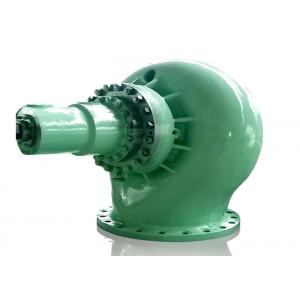

Add to Cart
Hydropower Station Pressure Regulating Valve/ Pressure Regulator Price
1.Product Introduction
Pressure regulating valve is long pressure diversion tunnel of a
hydropower station safety equipment, in general, when the pressure
water diversion pipe Σ LV/H is more than 15 ~ 30, to set up the
surge tank, due to large surge tank construction quantities, the
construction period is longer, the pressure regulating valve
instead of surge tank, can save investment, shorten the
construction period.
2.Application
The main body of the pressure regulating valve is arranged horizontally, that is, the center lines of the water inlet pipe and the oil cylinder are parallel to the ground, mainly composed of the valve housing, the valve plug, the main oil cylinder, the guide oil cylinder, and the air supplement valve.
3.operating principle
The control system of TFW pressure regulating valve adopts full hydraulic control and operation. The guide vane servomotor and pressure regulating valve are simultaneously controlled and operated through special main pressure valve and other components installed in the governor. Its working principle is as follows:
(1) When the load of the unit remains unchanged, the main pressure
valve piston is in the middle position, and the pressure oil P1
from the governor enters the closing chamber of the main oil
cylinder of the pressure regulating valve through the orifice A. At
this time, the oil pressure of the pressure regulating valve
closing chamber is P1. =P2, the opening chamber is open to drain
oil. Since the oil pressure in the closing chamber is greater than
the water thrust on the valve disc of the pressure regulating
valve, the pressure regulating valve is in the closed position.
(2) When the unit reduces the load (about 15% of the rated output
of the unit), because the upward displacement of the piston in the
middle valve disc of the main pressure distribution valve is less
than the overlap amount S, only a small amount of pressure oil P1
passes through the orifice at this time A enters the closing cavity
of the guide vane servomotor and slowly closes the guide vane. At
this time, the pressure drop △P formed by a small amount of
pressure oil through hole A is small, and the oil pressure in the
closing cavity of the pressure regulating valve (P2=P1-△P) can
still be Maintain the pressure regulating valve in the closed
position. At this time, the pressure regulating valve opens the
cavity to discharge oil. Therefore, when the load reduction is not
large, the pressure regulating valve does not act and the guide
vane servomotor closes slowly.
(3) When the unit instantaneously dumps a large amount of load (more than 15% of the rated output of the unit), the upward movement of the piston in the middle valve disc of the main pressure distribution valve is greater than the overlap amount S, and the pressure difference △P on both sides of the orifice increases , P2 is reduced, and the opening chamber of the main cylinder of the pressure regulating valve is connected to the pressure oil P1, the pressure regulating valve opens quickly, and the pressure oil discharged from the closing chamber of the pressure regulating valve plus a small amount of pressure oil through the A hole flows to the guide vane servomotor to close The cavity quickly closes the guide vanes. Since the same main pressure valve is used for control, the rapid opening of the pressure regulating valve and the rapid closing of the guide vane are synchronized and synchronized.
(4) When the load of the unit increases, the piston of the main
pressure distribution valve moves down, and the pressure oil P1
directly enters the opening cavity of the guide vane servomotor
(not restricted by the A hole), the pressure before and after the A
hole is equal, and the pressure regulating valve closes the cavity
oil pressure No change, the opening chamber is open to drain oil,
so the pressure regulating valve is still in the closed position.
(5) "Segmentation device": When the pressure regulating valve
starts to open quickly, the oil discharge of the guiding cylinder
is restricted by the orifice C and the oil pressure rises rapidly,
forcing the oil pressure check valve to overcome the oil pressure
and open, so In the process of rapid opening of the pressure
regulating valve, the pressure oil in its closing cavity only
partially closes the guide vane servomotor, while a small amount of
other pressure oil is continuously drained through the regulating
valve D, so the opening speed of the pressure regulating valve is
faster than that of the "segment device" "It speeds up when it is
not put in. When the regulating valve opens in advance to the
position restricted by the limit ring and stops (at this time the
guide vanes have not been fully closed), the oil pressure of the
guiding cylinder disappears, and the oil pressure check valve
quickly closes automatically. At this time, only a small amount of
pressure oil from hole A slowly continues to close the guide vane
servomotor, so that the guide vane is closed in two sections.
Therefore, the size of the opening of the regulating valve D can
directly control the inflection point position of the guide vane
section closing. After the guide vane is closed, when the speed of
the unit decreases to the normal speed, the main pressure control
valve returns to the middle position, the main oil cylinder of the
pressure regulating valve opens the cavity to discharge oil, so the
pressure oil P1 slowly closes the pressure regulating valve at the
specified speed through hole A .
